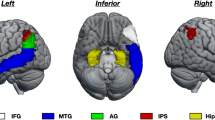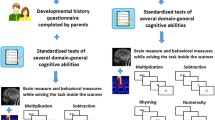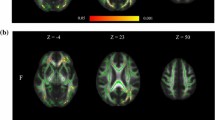Abstract
Connectivity between brain regions is integral to efficient complex cognitive processing, making the study of white matter pathways in clarifying the neural mechanisms of individual differences in arithmetic abilities critical. This white matter connectivity underlying arithmetic has only been investigated through classic diffusion tensor imaging, which, due to methodological limitations, might lead to an oversimplification of the underlying anatomy. More complex non-tensor models, such as spherical deconvolution, however, allow a much more fine-grained delineation of the underlying brain anatomy. Against this background, the current study is the first to use spherical deconvolution to investigate white matter tracts and their relation to individual differences in arithmetic fluency in typically developing children. Participants were 48 typically developing 9–10-year-olds, who were all in grade 4, and who underwent structural diffusion-weighted magnetic resonance imaging scanning. Theoretically relevant white matter tracts were manually delineated with a region of interest approach, after which the hindrance modulated orientational anisotropy (HMOA) index, which provides information on the structural integrity of the tract at hand, was derived for each tract. These HMOA indices were correlated with measures of arithmetic fluency, using frequentist and Bayesian approaches. Our results point towards an association between the HMOA of the right inferior longitudinal fasciculus and individual differences in arithmetic fluency. This might reflect the efficiency with which children process Arabic numerals. Other previously found associations between white matter and individual differences in arithmetic fluency were not observed.




Similar content being viewed by others
References
Andraszewicz S, Scheibehenne B, Rieskamp J, Grasman R, Verhagen J, Wagenmakers EJ (2015) An introduction to Bayesian hypothesis testing for management research. J Manag 41:521–543
Arsalidou M, Taylor MJ (2011) Is 2 + 2 = 4? Meta-analyses of brain areas needed for numbers and calculations. Neuroimage 54:2328–2393
Arsalidou M, Pawliw-Levac M, Sadeghi M, Pascual-Leone J (2018) Brain areas associated with numbers and calculations in children: meta-analyses of fMRI studies. Dev Cogn Neurosci 30:239–250
Assaf Y, Freidlin RZ, Rohde GK, Basser PJ (2004) New modeling and experimental framework to characterize hindered and restricted water diffusion in brain white matter. Magn Reson Med 52:965–978
Barnea-Goraly N, Menon V, Eckert M, Tamm L, Bammer R, Karchemskiy A, Reiss AL (2005) White matter development during childhood and adolescence: a cross-sectional diffusion tensor imaging study. Cereb Cortex 15:1848–1854
Basser PJ, Mattiello J, LeBihan D (1994) MR diffusion tensor spectroscopy and imaging. Biophys J 66:226–259
Ben-Shachar M, Dougherty RF, Wandell BA (2007) White matter pathways in reading. Curr Opin Neurobiol 17:258–270
Brus BT, Voeten MJM (1979) Een Minuut Test (one minute test). Swets & Zeitlinger, Lisse
Casey BJ, Tottenham N, Limston C, Durston S (2006) Imaging the developing brain: what we have learned about cognitive development. Trends Cogn Sci 9:104–110
Catani M, Mesulam M (2008) The arcuate fasciculus and the disconnection theme in language and aphasia: history and current state. Cortex 44:953–961
Catani M, Thiebaut de Schotten M (2008) A diffusion tensor imaging tractography atlas for virtual in vivo dissections. Cortex 44:1105–1132
Catani M, Jones DK, ffytche DH (2005) Perisylvian language networks of the human brain. Ann Neurol 57:8–16
De Vos T (1992) Tempo-Test-Rekenen. Berkhout, Nijmegen
De Smedt B (2016) Individual differences in arithmetic fact retrieval. In: Berch D, Geary D, Mann-Koepke K (eds) Development of mathematical cognition: Neural substrates and genetic influences, vol 2. Elsevier, San Diego, pp 219–243
De Smedt B, Boets B (2010) Phonological processing and arithmetic fact retrieval: evidence from developmental dyslexia. Neuropsychologia 48:3973–3981
De Smedt B, Holloway ID, Ansari D (2011) Effects of problem size and arithmetic operation on brain activation during calculation in children with varying levels of arithmetical fluency. Neuroimage 57:771–781
Dehaene S, Piazza M, Pinel P, Cohen L (2003) Three parietal circuits for number processing. Cogn Neuropsychol 20:487–506
Dell’Acqua F, Rizzo G, Scifo P, Clarke RA, Scotti G, Fazio F (2007) A model-based deconvolution approach to solve fibercrossing in diffusion-weighted MR imaging. IEEE T Biomed Eng 54:462–472
Dell’Acqua F, Simmons A, Williams SCR, Catani M (2013) Can spherical deconvolution provide more information than fiber orientations? Hindrance modulated orientational anisotropy, a true-tract specific index to characterize white matter diffusion. Hum Brain Mapp 34:2464–2483
Dick AS, Tremblay P (2012) Beyond the arcuate fasciculus: consensus and controversy in the connectional anatomy of language. Brain 135:3529–3550
Dienes Z (2011) Bayesian versus orthodox statistics: which side are you on? Perspect Psychol Sci. https://doi.org/10.1177/1745691611406920
Farquharson S, Tournier JD, Calamante F, Fabinyi G, Schneider-Kolsky M, Jackson GD, Connelly A (2013) White matter fiber tractography: why we need to move beyond DTI. J Neurosurg 118:1367–1377
Geary DC, Hoard MK, Byrd-Craven J, Desoto MC (2004) Strategy choices in simple and complex addition: contributions of working memory and counting knowledge for children with mathematical disability. J Exp Child Psychol 88:121–151
Grabner RH, Ansari D, Reishofer G, Stern E, Ebner F, Neuper C (2007) Individual differences in mathematical competence predict parietal brain activation during mental calculation. Neuroimage 38:346–356
Grotheer M, Jeska B, Grill-Spector K (2018) A preference for mathematical processing outweighs the selectivity for Arabic numbers in the inferior temporal gyrus. Neuroimage 175:188–200
Han BS, Hong JH, Hong C, Yeo SS, Lee DH, Cho HK, Jang SH (2010) Location of corticospinal tract at the corona radiata in human brain. Brain Res 1326:75–80
JASP Team (2017) JASP (Version 0.8.5) [Computer software]
Jeffreys H (1961) Theory of probability, 3rd edn. Oxford University, Oxford
Johansen-Berg H (2010) Behavioural relevance of variation in white matter microstructure. Curr Opin Neurol 23:351–358
Jones DK, Leemans A (2011) Diffusion tensor imaging. In: Modo M, Bulte JWM (eds) Magnetic resonance neuroimaging: methods and protocols. Humana, New York, pp 127–144
Kucian K, von Aster M, Loenneker T, Dietrich T, Martin E (2008) Development of neural networks for exact and approximate calculation: a fMRI study. Dev Neuropsychol 33:447–473
Kucian K, Ashkenazi SS, Hänggi J, Rotzer S, Jäncke L, Martin E, von Aster M (2014) Developmental dyscalculia: a dysconnection syndrome? Brain Struct Funct 219:1721–1733
Leemans A, Jeurissen B, Sijbers J, Jones DK (2009) ExploreDTI: A graphical toolbox for processing, analyzing, and visualizing diffusion MR data. In: Proceedings of the 17th Scientific Meeting, International Society for Magnetic Resonance in Medicine. Honolulu, p 3537
Li Y, Hu Y, Wang Y, Weng J, Chen F (2013) Individual structural differences in left inferior parietal area are associated with schoolchildren’s arithmetic scores. Front Hum Neurosci 7:1–8
Martino J, Brogna C, Robles SG, Vergani F, Duffau H (2010) Anatomic dissection of the inferior fronto-occipital fasciculus revisited in the lights of brain stimulation data. Cortex 46:691–699
Matejko A, Ansari D (2015) Drawing connections between white matter and numerical and mathematical cognition: a literature review. Neurosci Biobehav Rev 48:35–52
Menon V (2015) Arithmetic in the child and adult brain. In: Cohen Kadosh R, Dowker A (eds) The Oxford handbook of numerical cognition. Oxford University, Oxford, pp 502–530
Moeller K, Willmes K, Klein E (2015) A review on functional and structural brain connectivity in numerical cognition. Front Hum Neurosci. https://doi.org/10.3389/fnhum.2015.00227
Navas-Sánchez FJ, Alemán-Gómez Y, Sánchez-Gonzalez J, Guzmán-De-Villoria JA, Franco C, Robles O, Desco M (2014) White matter microstructure correlates of mathematical giftedness and intelligence quotient. Hum Brain Mapp 35:2619–2631
Peters L, De Smedt B (2018) Arithmetic in the developing brain: a review of brain imaging studies. Dev Cogn Neurosci 30:265–279
Polspoel B, Peters L, Vandermosten M, De Smedt B (2017) Strategy over operation: neural activation in subtraction and multiplication during fact retrieval and procedural strategy use in children. Hum Brain Mapp 38:4657–4670
Prado J, Mutreja R, Zhang H, Metha R, Desroches AS, Minas JE, Booth JR (2011) Distinct representations of subtraction and multiplication in the neural systems for numerosity and language. Hum Brain Mapp 32:1932–1947
Rivera SM, Reiss AL, Eckert MA, Menon V (2005) Developmental changes in mental arithmetic: evidence for increased functional specialization in the left inferior parietal cortex. Cereb Cortex 15:1779–1790
Rykhlevskaia E, Uddin LLQ, Kondos L, Menon V (2009) Neuroanatomical correlates of developmental dyscalculia: combined evidence from morphometry and tractography. Front Hum Neurosci. https://doi.org/10.3389/neuro.09.051.2009
Schmahmann JD, Pandya DN (2008) Disconnection syndromes of basal ganglia, thalamus, cerebrocerebellar systems. Cortex 44:1037–1066
Shum J, Hermes D, Foster BL, Dastjerdi M, Rangarajan V, Winawer J, Parvizi J (2013) A brain area for visual numerals. J Neurosci 33:6709–6715
Thiebaut de Schotten M, Dell’Acqua F, Forkel SJ, Simmons A, Vergani F, Murphy DGM, Catani M (2011) A lateralized brain network for visuospatial attention. Nat Neurosci 14:1245–1246
Torbeyns J, Verschaffel L, Ghesquière P (2004) Strategic aspects of simple addition and subtraction: the influence of mathematical ability. Learn Instr 14:177–195
Tournier JD, Calamante F, Gadian DG, Connelly A (2004) Direct estimation of the fiber orientation density function from diffusion-weighted MRI data using spherical deconvolution. Neuroimage 23:1176–1185
Tournier JD, Calamante F, Connelly A (2007) Robust determination of the fibre orientation distribution in diffusion MRI: non-negativity constrained super-resolved spherical deconvolution. Neuroimage 35:1459–1472
Tsang JM, Dougherty RF, Deutsch GK, Wandell BA, Ben-Shachar M (2009) Frontoparietal white matter diffusion properties predict mental arithmetic skills in children. Proc Natl Acad Sci USA 106:22546–22551
Tuch DS (2004) Q-ball imaging. Magn Res Med 52:1358–1372
Van Eimeren L, Niogi SN, McCandliss BD, Holloway ID, Ansari D (2008) White matter microstructures underlying mathematical abilities in children. Neuroreport 19:1117–1121
Van Beek L, Ghesquière P, Lagae L, De Smedt B (2014) Left fronto-parietal white matter correlates with individual differences in children’s ability to solve additions and multiplications: a tractography study. Neuroimage 90:117–127
Van den Bos KP, Spelberg HCL, Scheepstra ASM, De Vries JR (1994) De Klepel: pseudowoordentest. Berkhout, Nijmegen
Vanderauwera J, Vandermosten M, Dell’Acqua F, Wouters J, Ghesquière P (2015) Disentangling the relation between left temporoparietal white matter and reading: a spherical deconvolution tractography study. Hum Brain Mapp 36:3273–3287
Von Der Heide RJ, Skipper LM, Klobusicky E, Olson IR (2013) Dissecting the uncinate fasciculus: disorders, controversies and a hypothesis. Brain 136:1692–1707
Wakana S, Caprihan A, Panzenboeck MM, Fallon JH, Perry M, Gollub RL, Mori S (2007) Reproducibility of quantitative tractography methods applied to cerebral white matter. Neuroimage 36:630–644
Wang R, Benner T, Sorensen AG, Wedeen VJ (2007) Diffusion toolkit: a software package for diffusion imaging data processing and tractography. In: 15th Annual Meeting, International Society for Magnetic Resonance in Medicine. Berlin
Wechsler D (2005) Wechsler Intelligence Scale for children—WISC-III-NL. Pearson, Amsterdam
Wedeen VJ, Hagmann P, Tseng WYI, Reese TG, Weisskoff RM (2005) Mapping complex tissue architecture with diffusion spectrum magnetic resonance imaging. Magn Reson Med 54:1377–1386
Woodcock RW, McGrew KS, Mather N (2003) Woodcock–Johnson III tests of achievement. Riverside, Itasca
Zhao J, Thiebaut de Schotten M, Altarelli I, Dubois J, Ramus F (2016) Altered hemispheric lateralization of white matter pathways in developmental dyslexia: evidence from spherical deconvolution tractography. Cortex 76:51–62
Acknowledgements
This study was supported by a project of the Fund for Scientific Research Flanders (G.0946.12), by a federal research action (IUAP P7/11), and by a project of the Fund for Scientific Research Flanders and the Austrian Science Fund (G.0027.16). We would also like to thank all participants, their parents, and the Department of Radiology of the University Hospital in Leuven for their support.
Funding
This study was funded by a project of the Fund for Scientific Research Flanders (G.0946.12), by a Belgian federal research action (IUAP P7/11), and by a project of the Fund for Scientific Research Flanders and the Austrian Science Fund (G.0027.16).
Author information
Authors and Affiliations
Corresponding author
Ethics declarations
Informed consent
Written informed consent was obtained from all individual participants included in the study, as well as from a parent or legal guardian of each participating child.
Ethical approval
All procedures involving human participants were in accordance with the ethical standards of the institutional and/or national research committee and with the 1964 Helsinki declaration and its later amendments or comparable ethical standards. The study was approved by the Medical Ethical Committee of the University of Leuven (S59167).
Conflict of interest
The authors declare that they have no conflict of interest.
Electronic supplementary material
Below is the link to the electronic supplementary material.
Rights and permissions
About this article
Cite this article
Polspoel, B., Vandermosten, M. & De Smedt, B. Relating individual differences in white matter pathways to children’s arithmetic fluency: a spherical deconvolution study. Brain Struct Funct 224, 337–350 (2019). https://doi.org/10.1007/s00429-018-1770-6
Received:
Accepted:
Published:
Issue Date:
DOI: https://doi.org/10.1007/s00429-018-1770-6




